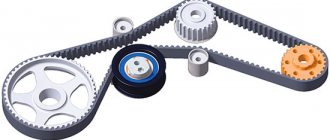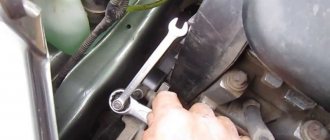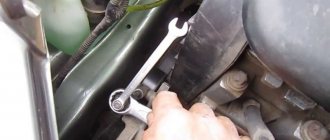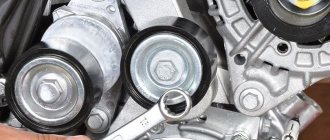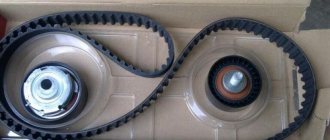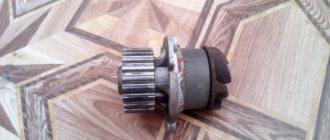2013 was the year of birth of the Lada Kalina 2, which was almost completely modernized compared to its predecessor. The car has become popular not only in the regions of the Russian Federation, but also in countries far and near abroad. The car belongs to the small class, but has quite good capacity.
Lada Kalina 2 or VAZ 2192 is equipped with a line of power units with a displacement of 1600 cm3. They differ not only in power indicators, but also in the number of valves in the cylinder head. There can be 8 (engine 11186) or 16 (engines 21126 and 21127), the timing mechanism is driven by a toothed belt.
Replacing the timing belt on an 8-valve engine
If the car owner believes that the time has come, the belt in the timing drive mechanism needs to be replaced, this procedure should be performed. Most owners trust this work to specialists, but with a lot of desire and car maintenance skills, it can be done independently. This matter should not be postponed until the “future”, since a broken belt will lead to damage to the valves in the cylinder head. The replacement work will require the driver about two hours.
Timing diagram VAZ 11186
You should purchase consumables, prepare a set of wrenches, a car jack, a stand for the car body, and chocks for the rear wheels of the car.
If you plan to replace the coolant pump, you need to have antifreeze to add it to the engine cooling system.
And you will also need a key to adjust the tension of the timing belt. You can start work in the garage or any other horizontal area. In addition, you will need a set of hexagons of different sizes. For ease of work, it is best to remove the front right wheel.
To do this, tighten the handbrake lever on the installed car, install pads under the rear wheels, and remove the wheel bolts with a wheel wrench. Further work will be carried out in the engine compartment, so you need to open the hood. To gain access to the timing drive, the protective cover must be removed. You will need the fifth hexagon number, which is used to remove 3 screws on the plastic cover.
Protective cover mounting bolts
Removing the protective cover
Drain a small amount of antifreeze from the engine cooling system if the pump is changed.
Next, the timing belt replacement begins.
- It is necessary to unscrew the stud of the generator tensioning device with a “10” head and remove its belt. After this, you should set the timing drive according to the marks. This is best done with the wheel removed from the right side of the car. The car is lifted with a jack. For reliability, install a stand under the threshold of the car and remove the wheel. Now, using a wrench, you need to rotate the bolt on the crankshaft pulley clockwise until the mark on the camshaft pulley coincides with the mark on the rear protection cover.
- You will need a hex number five to remove the lower timing belt guard. Next, you need to remove the crankshaft pulley; you will need an assistant for this. He must engage fifth gear and press the brake pedal. At this time, use a wrench with an extension to unscrew the pulley mounting bolt and remove it. The protective washer behind it is also removed. The mark on the gear wheel should coincide with the casting on the oil pump cover. The next step is to release the tension of the drive belt. Unscrew the tensioner mounting bolt, remove it together with the adjusting washer, and then return it to its place.
- Remove the old belt from the pulleys. If necessary, dismantle the engine cooling system pump. Before installing a new part, carefully inspect the gears. Pump pulley in the engine cooling system. The tension roller is usually always replaced with a new product.
- Before installing a new belt, check once again that the timing marks match; if everything is in order, continue working. Place the tensioner roller in place along with the adjusting washer, but do not tighten it. Place the belt on the camshaft gear, then the crankshaft pulley, pump and tension roller.
- The timing belt is tensioned using a special wrench by turning the tensioner roller; the direction of movement is indicated on the roller body. Turn it until the marks on the movable and fixed roller bushings match, then tighten the tensioner mounting bolt.
Next, on the VAZ-11186 engine, all the removed parts are put back in place, after which they make several revolutions of the engine crankshaft and check that the installation marks match. If they match, then the timing belt replacement procedure has been completed correctly.
Are the valves bending?
Unfortunately, this sometimes happens on an 8-valve engine if the timing belt in the timing drive is damaged. Experts strongly recommend constantly paying attention to the condition of the timing drive during maintenance in order to promptly identify possible problems in the valve mechanism. A broken belt will lead to additional costs for repairing the power unit, which will be several times higher than the cost of a belt with a tension roller.
Signs of critical belt wear
Signs of wear are distinguished: direct and indirect.
Direct signs of wear include:
- presence of cracks on the belt surfaces (external and internal);
- chips on the inner surfaces of the teeth;
- longitudinal sections on the outer surface;
- presence of heavy contamination;
- visible runout and stretching of the timing belt;
- extreme cases - belt breakage, “licking” of teeth.
The listed signs can be detected by visual inspection. In most cases, this requires removing the belt cover. In some car models, this requires “hanging” the engine and carrying out a series of dismantling works. Therefore, before deciding to diagnose the condition of the belt drive, it is necessary to evaluate indirect signs of wear, which include:
- misfires in engine cylinders;
- detonation, especially at the moment of shutdown;
- uneven idle speed.
These signs can be examined using computer diagnostics. The most effective diagnostic result is achieved by studying the ignition angle in dynamic mode (with the engine running). Typically it should be within plus or minus five degrees. In this case, the ignition timing when the engine rotates at idle speed should not change significantly.
Replacing the timing belt on a 16 valve engine
To change the belt in the drive of VAZ-21126, VAZ-21127 engines, no special conditions are required. You will need sockets for “10”, “15”, “17”, the fifth hexagon number, and a powerful screwdriver with a flat blade. The cylinder head of these engines has 16 valves, which means there will also be two camshafts.
The replacement can be done something like this:
- Open the engine compartment hood and disconnect the terminals from the battery.
- Using a hexagon number 5, unscrew 5 bolts of the upper protective timing cover and 2 screws of the lower protection.
- Rotate the head to “17” by the bolt on the crankshaft pulley to set the timing mechanism to the TDC position of the first cylinder. In this case, the marks not only on the crankshaft and camshaft pulleys, but also on the flywheel and the gearbox housing must match.
- Next, use a screwdriver to stop the crankshaft from turning by inserting its blade between the teeth of the flywheel ring and the gearbox housing.
Fixing the crankshaft from turning
- Release the generator set belt tensioner and remove it from the pulleys.
Removing the generator drive pulley
- Next, unscrew the crankshaft pulley fastening screw and dismantle it along with the spacer washer.
- By loosening the belt tension (to do this, turn the tensioner), you can remove the belt from the timing drive.
After this, it is strictly forbidden to turn the crankshaft.
- Before assembly, carefully check the condition of all timing parts and the alignment of the installation marks.
- After installing new tension and guide devices, you can put on the belt.
- They start with the camshaft pulleys, making sure that the belt branch between them does not have a deflection.
- When the belt is placed on the pulleys of the pump, crankshaft, tensioner, it needs to be tensioned.
- Snap ring pliers work well for this purpose. They are inserted into the grooves that are in the outer cage of the tensioner and rotated counterclockwise. When the marks on the tensioner clips match, you can tighten its fasteners.
- Then reassemble everything in reverse order. Upon completion of assembly, before starting the engine, you should rotate the crankshaft several revolutions, while monitoring the position of the alignment marks.
What's wrong with the valves?
As with an 8-valve engine, damage to the belt of 16-valve engines leads to dire consequences: the valves bend. Motor mechanics cite facts where, in addition to valves, pistons were damaged, connecting rods were bent, and valve bushings burst. This resulted in engines requiring expensive overhauls. There is no need to save on consumables for the valve mechanism drive, otherwise the owner will face big troubles associated with repair work on the power unit.
After how many thousand kilometers does it need to be changed?
It is impossible to accurately predict the life expectancy of a timing belt, especially if it has already been changed and a non-original mechanism part has been installed. Installing a non-original part is generally quite a risky endeavor, which can lead to unpleasant consequences for the mechanism and the engine as a whole.
When determining the frequency of replacement, you should also take into account the operating conditions of the vehicle. A number of factors affect the life of a timing belt. In addition to the fact that the part is constantly exposed to dynamic loads, temperature changes in the engine compartment, contact with random objects, ingress of liquids, dirt, etc., have an adverse effect. Damage and incorrect operation of other elements of the gas distribution mechanism can also accelerate wear.
When to change the timing belt can be found out from the technical documentation for the vehicle, since for a specific brand of car the frequency of replacement may differ due to design features, as well as the material of the product itself. On average, the timing belt needs to be changed after 50,000 kilometers of a car’s mileage, and no matter what mileage is indicated by the manufacturer, it must be taken into account that this refers to ideal operating conditions. So if the documentation states a figure of 120,000 km, then it can be safely reduced by 30-40,000 km.
For a new domestically produced car, the part usually needs to be replaced after 60,000 km, for an imported car after 70-80,000 km. If the timing belt on the car has already been changed, the timing is reduced to 50,000 and 60-70,000 km, respectively.
Tests and tests
Experts from the Za Rulem magazine tested 36 drive belts - 6 copies of each from six different brands. The test results refer to specific product samples and do not allow us to judge the entire range of products of each item.
- Continental, Germany. Approximate price 850 ₽. There can be no complaints about a belt that has stood for 400 hours on the stand and could continue to work. In our tests, only two products were able to demonstrate this.
- Gates, UK. Approximate price 1150 ₽. 400 hours on the bench are sufficient grounds for unequivocal approval.
- Trialli, China. Approximate price 700 ₽. 286 hours is, let’s say, a strong middle peasant, which, unlike the leaders, nevertheless became toothless, although it lasted quite a long time, exceeding the requirements of the technical specifications. At the same time, strength tests have shown that some belt parameters are even better than those of the champions.
- Gates (fake with reference to Germany). Approximate price 350 ₽. Which is what needed to be proven: “You, priest, should not chase after cheapness.” After just 3 hours of life tests, the belt lost its “teeth”: a complete failure. Checking individual parameters confidently placed the product in last place: such belts cannot be installed!
- Lynx, Japan. Approximate price 650 ₽. During endurance tests, the belt lasted 104 hours, after which some of the teeth were cut off. In general, not so little, but the leaders worked four times longer and were not injured! The remaining parameters are not failures, but overall we are looking at an mediocre product.
- Balakovorezinotekhnika (BRT), Russian Federation. Approximate price 750 ₽. Just 1 hour on the stand instead of the champion 400 - what can I say? Alas, the teeth came off the cord almost immediately. It feels like the belts are made of raw rubber. Note that after drying, the cutting force of the tooth more than doubled - and this turned out to be the best result. But the breaking forces are low, and according to the results of bench tests - the penultimate place.
Cost of work by Prices
replacing a Lada Kalina timing belt in our auto shops varies from 400 to 1000 rubles per If. The unit also requires replacement of the tension roller - be prepared to shell out another 400-600 rubles.
The cost of replacing a belt 500 is 800 rubles. With a roller – up to 1000 Buying.
rubles for a timing belt, it is better to give preference to a branded VAZ product. If this is not possible, you can purchase an analogue produced by some well-known brand. Below are examples where the catalog numbers of the original and worthy belts of imported analogues are indicated.
How to independently determine that it is time to change the belt
As mentioned above, a part can wear out much earlier than expected. You should be especially careful when buying a used car. A motorist can determine belt wear independently, but depending on the design, inspection may not be possible without the use of special tools. Taking into account the fact that a part always wears out to varying degrees, it is not worth neglecting to assess its condition, even if the time for the proposed replacement has not yet arrived.
A number of signs of wear that indicate replacement:
- cracks or other defects on the inside and outside of the product;
- longitudinal sections along the length of the part;
- worn teeth;
- severe contamination of the consumable;
- oil leakage, contact with the product;
- Belt breakage is a critical case.
The question of how to check the timing belt should be approached based on the characteristics of the mechanism. The above signs of wear can be noticed visually, but most often this requires dismantling the protective cover of the part. Some car brands require the engine to be suspended for this purpose. Diagnostics should be carried out unambiguously if signs hinting at wear are noticed, these are interruptions in the functioning of the car’s heart:
- detonation of the power unit;
- misfires in the cylinders;
- Rough idle.
Computer diagnostic research can accurately identify these signs. The most effective way is to check the ignition angle with the engine running (normal deviation is up to five degrees), but at idle it should not change significantly.
Replacing a timing belt requires certain skills and appropriate tools. Often during installation it is necessary to adjust the ignition timing. Many control systems block the motor from starting at an incorrect angle in order to prevent destruction of the mechanism.
faults Basic
There can only be three main faults with the timing belt:
- violation of integrity is not enough;
- structures - or overtension;
- break.
In the first case, the belt may simply delaminate, as evidenced by dangling reinforcing threads. In addition, this often occurs when belt teeth are cut off. These problems are the result of mechanical damage, incorrect adjustment:
- camshaft stars;
- crankshaft pulley;
- roller shaft;
- pumps;
- tension roller.
The tension roller is designed to tension the rotation belt around its own eccentric axis.
If it is adjusted incorrectly, the belt may be too tight, which will sooner be too late or render it unusable. The same problem will arise if the belt is loose. The most unpleasant surprise, especially on the road, is a broken timing belt. In this case, the engine will stall instantly, and it will be possible to start it only by installing a new belt.
Article numbers of original parts
Lada Granta, Kalina with 8-valve engines (VAZ 11183):
- Belt - 21080100604010 (“BalakovoRezinoTekhnika” PJSC Balakovo)
- Tension roller assembly - 21080100612000 (“VPK” JSC Vologda)
- Tension roller assembly - 21080100612001 (TD EPK LLC, Moscow)
Timing kit 2108 - 21080100604086 (Gates CIS LLC, Moscow). The kit includes a belt and a roller. This is the GATES K015521 kit, only in LADA branded packaging.
Lada Granta, Kalina, Priora with 8-valve engines (VAZ 11186, 11189)
:
- Toothed belt assembly - 21116100604000 (Gates CIS LLC, Moscow)
- Toothed belt assembly - 21116100604082 (Gates CIS LLC, Moscow)
- Tension roller - 21116100623800 (Gates CIS LLC, Moscow)
- Tension roller - 21116100623882 (Gates CIS LLC, Moscow)
Timing kit - 21116100604086 (Gates CIS LLC, Moscow). The kit includes a belt and a roller. This is the GATES K015670XS kit, only in LADA branded packaging.
Lada Granta, Kalina, Priora, Largus Vesta, XRAY with 16-valve engines (VAZ 21126, 21127, 21129 and 21179)
:
- Reinforced toothed belt - 21126100604000 (Gates CIS LLC, Moscow)
- Reinforced toothed belt - 21126100604082 (Gates CIS LLC, Moscow)
- Toothed belt - 21126100604001 (ContiTech Antriebssysteme GmbH)
- Support roller - 21126100613500 (“Lada Holding” GMBH Vienna)
- Support roller assembly - 21126100613501 (Schaeffler Technologies GmbH & Co. KG)
- Automatic toothed belt tensioner - 21126100623800 (“Lada Holding” GMBH Vienna)
Timing kit 21126 - 21126100604086 (Gates CIS LLC, Moscow). The kit includes a belt and 2 rollers. This is the GATES K015631XS kit in LADA branded packaging, which is installed on the AVTOVAZ conveyor.

